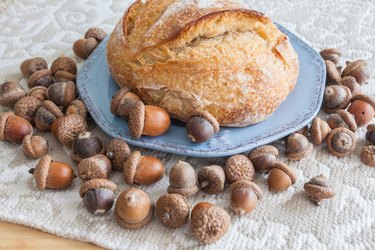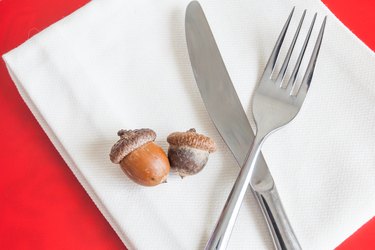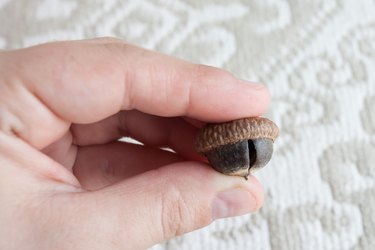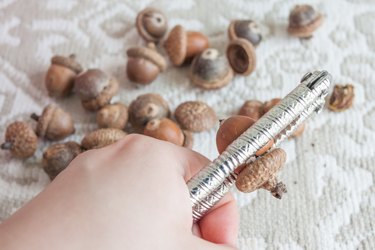
Acorns are the nuts that are grown on oak (Quercus) trees. There are more than 300 varieties of oak trees and all of them produce acorns that are harvested for eating in the fall. White oaks can produce anywhere from four bushels to nearly a ton of acorns every year. Red oaks produce these amounts every other year because their acorns need two growing seasons to fully mature.
Video of the Day
Red and White Oaks

Fresh acorns that haven't been processed are very bitter to eat because they still contain tannin. Some acorns have more tannin than others. Acorns that come from a red oak are rich in tannins and taste very bitter. They are not commonly used for eating because they require extra leaching. Acorns from white oaks contain fewer tannins, taste less bitter than acorns from red oaks, and are commonly processed for eating. To identify if an oak is a red or a white, examine the leaves. The leaves of the red oak have bristles at the tips of the leaves while the leaves of the white oak have no bristles and the leaf tip is slightly rounded.
Harvesting

Harvest acorns in the fall when they begin to fall from the trees. Pick them up from the ground each day or lay a tarp under the trees to capture the falling acorns. As you gather the acorns, inspect them and look for any holes or cracks in the shell. Discard any acorns that show damage to the shell.
Removing the Tannin

Before eating acorns, the nuts must be shelled and leached to remove the tannins. Crack open the shell of each acorn with a hammer or a nut cracker and remove the nut inside. Grind the nuts in a blender or put them in a plastic food bag and crush them with a mallet or rolling pin. Put the acorn meal in a large pot of boiling water. The water will turn dark as the tannin is released from the acorns. Remove the pot from the burner and let it cool until you are able to safely handle it. Pour out the dirty water and add fresh water to the pot. Bring the acorn meal to a boil again. Repeat this process of leaching out the tannin for a total of five times.
Acorn Flour

After the tannin has been leached from the acorn meal, the meal must be dried. Spread the meal on a baking sheet and dry it in the oven. Set the oven on its lowest temperature and keep the oven door open so that the moisture from the acorn meal can escape. Stir the acorn meal every 30 minutes until the meal appears dry, in four to eight hours. Acorn meal can also be dried in a food dehydrator. Spread the meal out on a fruit leather tray and set the drying temperature at 90 to 100 degrees Fahrenheit. It will take eight to 10 hours for the meal to dry in a dehydrator. Sun dried acorn meal is placed in a warm, sunny room and is covered with one layer of cheesecloth to prevent insects and dust from getting onto the meal. It can take one to two days until the meal is completely sun dried. Test the dried meal. If it is dry, you will feel no water content when your squeeze the meal between your fingers and the nut will be tender, not brittle. After the meal is dried, grind it into a coarse flour using a grain grinder. Store the flour in strong plastic food bags or in clean glass jars in the refrigerator or the freezer. Use within one month.
Using in Recipes

Acorn flour can be used in breads, cookies and cakes. You can also replace cornmeal with acorn flour in any recipe. In recipes that call for oats, replace half of the oats with acorn flour. In bread recipes, replace one-quarter of the wheat or bread flour with acorn flour.










































